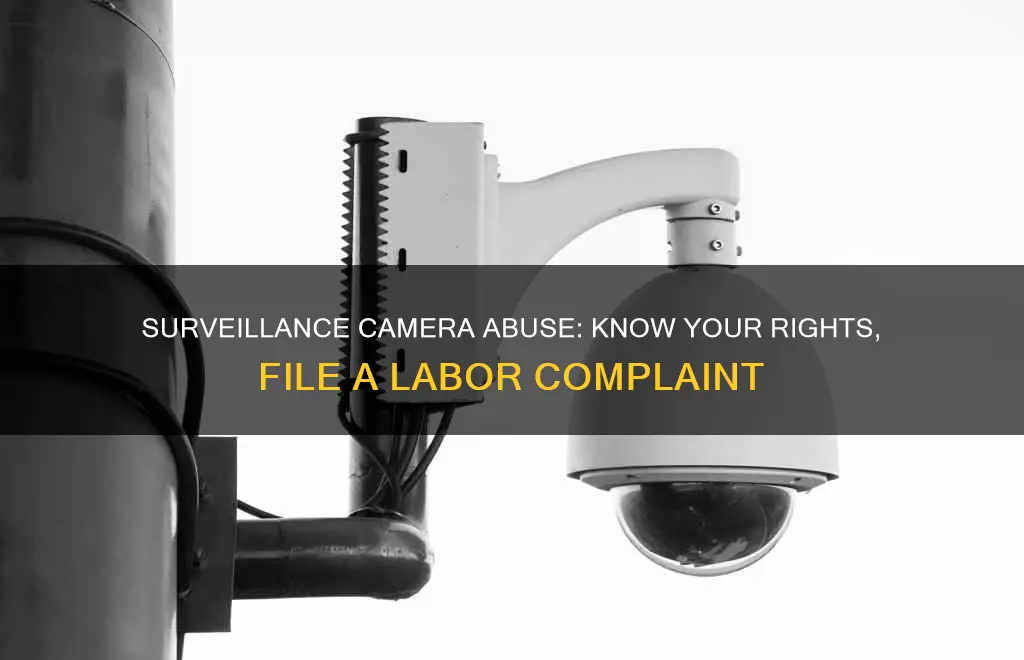
Surveillance cameras in the workplace are often used to ensure workplace safety, deter theft, fraud, or other inappropriate behaviours, and monitor workflow. However, the use of surveillance cameras must be balanced with employees' privacy rights. While there is no federal law prohibiting the use of surveillance cameras in the workplace, there are state laws and ethical considerations that employers must comply with. If you believe that your privacy rights have been violated due to the misuse of surveillance cameras at work, you can take several steps to address and rectify the situation. This includes documenting the violation, gathering evidence, and approaching your supervisor or HR department to discuss your concerns. You may also need to contact your state labour department or a lawyer specialising in employment law for guidance on your specific situation.
| Characteristics | Values |
|---|---|
| Contact | Wage and Hour Division, U.S. Department of Labor |
| Contact details | 1-866-487-9243 or visit dol.gov/agencies/whd |
| Information required | Address, phone number, company name, company location, company phone number, manager or owner's name, type of work, how and when paid, pay stubs, personal records of hours worked, other information on employer's pay practices |
| Additional notes | All services are free and confidential; employers cannot terminate or discriminate against employees for filing a complaint |
| Surveillance laws | Varies by state; some states have passed laws that deal with workplace privacy |
| Surveillance restrictions | Surveillance is prohibited in areas designed for employee rest or comfort, such as restrooms, locker rooms, or employee lounges |
| Surveillance justification | Legitimate business purpose, e.g., preventing theft or workplace violence, investigating illegal or improper conduct, monitoring employee performance |
| Surveillance methods | Least intrusive time, place, and method; visible cameras or written notification of hidden cameras; written employee consent |
| Surveillance location restrictions | Areas where employees have a reasonable expectation of privacy, e.g., bathrooms, locker rooms, dressing rooms, employee homes |
| Surveillance audio restrictions | Federal and state wiretap and recording laws must be followed when capturing or recording sound |
| Unionized workplaces | Comply with provisions in the collective bargaining agreement; negotiate with the union before implementing video surveillance |
| Surveillance subject selection | Non-discriminatory, e.g., do not discriminate based on gender, race, religion, or disability |
| Surveillance use | Not to be used for purposes other than security or quality control; not to be used to discriminate or harass employees |
What You'll Learn

Documenting the violation
To file a labor complaint for the misuse of surveillance cameras, you must first thoroughly document the violation. Here are some detailed steps and guidelines to help you through this process:
- Understand the Legality of Surveillance in Your State: The laws governing workplace surveillance vary from state to state. Some states have specific laws addressing video surveillance, while others follow general federal guidelines. It's important to research and understand the specific laws and restrictions in your state regarding the use of surveillance cameras in the workplace.
- Identify Hidden Cameras: If you suspect the presence of hidden cameras, try to locate them. Check for small, discreet devices that may be hidden in areas where there is a reasonable expectation of privacy, such as bathrooms, locker rooms, or personal offices.
- Document the Locations of Cameras: Make a record of the locations of all visible and hidden cameras. Note the areas they are monitoring and whether they capture footage, audio, or both. This information will be crucial when filing your complaint.
- Record Your Observations: Keep a detailed log of your observations and interactions with the surveillance system. Note the dates, times, and any unusual or suspicious activity you notice. For example, if cameras are moved to different locations or if footage is being reviewed by unauthorized individuals.
- Gather Evidence: If possible, obtain photographs or video recordings of the surveillance cameras, especially in areas where there is a reasonable expectation of privacy. This visual evidence will strengthen your complaint.
- Collect Witness Statements: Talk to your colleagues and gather their statements regarding the misuse of surveillance cameras. Their experiences and perspectives can provide additional support for your claim.
- Review Company Policies: Examine your company's policies and guidelines regarding surveillance. Look for any discrepancies or violations of these internal policies, as this can be used as evidence of improper use.
- Consult an Attorney: Consider seeking legal advice from an employment law attorney, especially if you intend to take legal action. They can guide you through the specific laws in your state and help you build a strong case.
- Contact Your State Labor Department: Reach out to your state labor department to learn more about your rights and the specific workplace privacy laws in your state. They can provide you with additional resources and guidance on filing a complaint.
- Maintain Confidentiality: Avoid discussing your plans to file a complaint with anyone who is not trusted or directly involved. The confidentiality of your complaint is essential to protect your privacy and the integrity of the investigation process.
Remember, the key to successfully documenting the violation is to be thorough, discreet, and well-informed about your rights and the applicable laws.
Reviving Dead Camera Batteries: Simple Hacks to Try
You may want to see also

Collecting witness accounts
When filing a labor complaint for the misuse of surveillance cameras, collecting witness accounts is an important step in building your case. Here are some detailed instructions on how to go about this process:
- Speak to your colleagues: They may have noticed similar issues or have valuable information that could strengthen your claim. It is important to obtain written statements from witnesses, but ensure that these are given voluntarily.
- Confidentiality: Keep the identities of your witnesses confidential to protect them from any potential retaliation.
- Document witness statements: When speaking to colleagues, be sure to write down what they say and, if possible, get them to provide a written account of their observations. This will help ensure that you have accurate records of their statements.
- Details: Encourage witnesses to provide as much detail as possible, including dates, times, locations, and any specific instances of misuse of surveillance cameras.
- Voluntariness: Ensure that witnesses understand that their participation is entirely voluntary and that they are not obligated to provide statements.
- Anonymity: If witnesses prefer to remain anonymous, respect their wishes and do not disclose their identities without their consent.
- Variety of perspectives: Speak to a diverse range of colleagues, including those from different departments or shifts, as this can provide a more comprehensive understanding of the situation.
Moultrie Cameras: Where Are They Manufactured and Why?
You may want to see also

Maintaining records
- Contact Information: Keep a record of your contact information, including your address and phone number, so that the relevant authorities can easily reach you regarding your complaint.
- Employer Information: Document the name, location, phone number, and manager/owner's name of the company where you work or worked. This information helps the authorities identify and contact the correct employer.
- Type of Work: Note down the type of work you performed. This helps provide context to your complaint and understand the nature of your job.
- Payment Information: Maintain records of how and when you were paid, such as through cash or check, and the frequency of payments (e.g., every Friday). This information can be crucial in cases involving wage-related complaints.
- Personal Records: Keep track of your personal records related to work hours, such as copies of pay stubs, timesheets, or any other documentation that shows your work hours and compensation. These records can serve as evidence to support your claims.
- Employer's Pay Practices: If possible, gather information about your employer's pay practices. This may include policies, guidelines, or any other relevant information that can help authorities understand the employer's compensation processes.
- Additional Information: Collect any other relevant information or documentation that can support your complaint. This could include emails, text messages, or other forms of communication related to your concerns.
It is important to maintain these records safely and securely. Make sure to keep both physical and digital copies, if possible. Additionally, ensure that any digital records are backed up to prevent data loss. Maintaining comprehensive and well-organized records will strengthen your labor complaint and improve your chances of a successful outcome.
The Evolution of Cameras: From First Invention to Now
You may want to see also

Reporting internally
If you believe that your privacy rights have been violated by your employer's misuse of surveillance cameras, there are several steps you can take to address the issue internally before filing a formal labour complaint. Here is a detailed guide on how to handle the situation:
Understand Your Rights and Company Policies:
Before taking any action, educate yourself about your rights as an employee and your company's internal policies on surveillance. In many jurisdictions, employees have a legal right to privacy, and employers must balance their business interests with their employees' privacy expectations. Familiarize yourself with any federal, state, or local laws that pertain to workplace surveillance in your area. Additionally, review your employee handbook or any other relevant company documents that outline their surveillance practices and guidelines.
Document Evidence:
If you believe your employer is misusing surveillance cameras, start gathering and documenting evidence to support your claim. Note the locations of the cameras, whether they are visible or hidden, and if they are capturing audio or solely video footage. Take note of any instances where you believe your privacy has been violated, such as cameras in areas where you would expect privacy (e.g., bathrooms, locker rooms). If possible, gather statements from other employees who may have similar concerns or experiences.
Address the Issue with Your Employer:
Once you have a clear understanding of your rights and the company's policies, approach your supervisor or the relevant person in the human resources department to discuss your concerns. It is advisable to arrange a private meeting to express your concerns calmly and professionally. Present the evidence you have gathered and explain how the misuse of surveillance cameras is affecting you and potentially other employees. It is important to remain respectful and open to dialogue during this conversation.
Suggest Alternative Solutions:
During your discussion with the relevant authority, propose alternative solutions that can address your privacy concerns while still allowing your employer to achieve their legitimate business objectives. For example, suggest the use of visible cameras instead of hidden ones or propose alternative methods of monitoring that are less intrusive. Offer to collaborate with them to find a solution that respects your privacy rights while also addressing their security or performance monitoring needs.
Follow Up and Document the Outcome:
After your meeting, follow up with an email or written correspondence summarizing the discussion, the concerns raised, and any proposed solutions. This documentation will be crucial if you need to escalate the matter further. If your employer takes steps to address the issue, such as relocating cameras or changing their surveillance practices, acknowledge their efforts and continue to monitor the situation to ensure your privacy rights are respected.
Remember, it is always best to try to resolve issues internally before pursuing external options. By following these steps, you can effectively address your concerns about the misuse of surveillance cameras in the workplace and work towards a mutually agreeable solution with your employer.
Get Camera Raw Plugin for CS4 With These Steps
You may want to see also

Consulting human resources
If you believe that your employer is misusing surveillance cameras, the first step is to consult your company's human resources (HR) department. HR professionals are responsible for ensuring compliance with employment laws and can provide guidance on your rights and options for addressing the issue. Here is a step-by-step guide on consulting HR regarding the misuse of surveillance cameras in the workplace:
- Understand Your Rights: Before approaching HR, educate yourself on your rights as an employee when it comes to surveillance in the workplace. As mentioned earlier, filming employees at work may violate their right to privacy. This right to privacy varies depending on the state you live in and the specific circumstances of the surveillance. Familiarize yourself with your state's workplace privacy laws, which you can find by contacting your state labor department.
- Review Company Policies: Before taking your concerns to HR, review your company's policies on surveillance, privacy, and employee monitoring. Look for any relevant documents, such as an employee handbook, surveillance guidelines, or privacy statements. Understanding your company's internal policies will help you identify potential violations and approach HR with specific concerns.
- Document Evidence: If you believe your employer is misusing surveillance cameras, start collecting evidence. Note the locations of the cameras, whether they are visible or hidden, and the areas they are monitoring. Also, take note of any instances where you believe your privacy has been violated, such as cameras in restrooms or locker rooms. If possible, gather statements from other employees who share similar concerns.
- Schedule a Meeting: Contact your HR department and schedule a meeting to discuss your concerns. You can do this via email or by speaking directly to an HR representative. It is advisable to put your concerns in writing, as this creates a record of your complaint. In your email, briefly outline your concerns about the misuse of surveillance cameras and request a meeting to discuss the matter further.
- Present Your Concerns: During the meeting, clearly and calmly express your concerns about the misuse of surveillance cameras. Provide specific examples and refer to any relevant company policies or state laws that you believe are being violated. For instance, mention if the cameras are in areas where employees have an expectation of privacy, such as restrooms or changing rooms.
- Propose Solutions: In addition to voicing your concerns, propose potential solutions that can address the misuse of surveillance cameras. For example, suggest that the company review and update its surveillance policies to align with state laws and employee privacy rights. You could also recommend that the company conduct training sessions to educate employees about their rights and the appropriate use of surveillance equipment.
- Follow Up: After the meeting, follow up with the HR department to ensure that your concerns are being addressed. Ask for updates on any actions taken and provide additional information or evidence if necessary. It is important to maintain a record of all communications and responses from the HR department.
- Seek Further Assistance: If you feel that your concerns are not being adequately addressed by the HR department, you can seek further assistance from external sources. Consider contacting an employment law attorney or a government agency, such as the U.S. Department of Labor, to understand your legal options and the process for filing a formal complaint.
Remember, it is your right to work in an environment that respects your privacy, and HR professionals are there to support you in upholding these rights. Don't hesitate to reach out and utilize the resources available to you.
Target's Surveillance: Are Shoppers Being Watched?
You may want to see also







